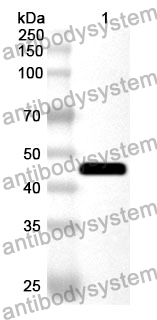Catalog No.
PHJ83601
Species reactivity
Human, Mouse, Rat
Host species
Rabbit
Isotype
IgG
Clonality
Polyclonal
Immunogen
E. coli - derived recombinant Human HDAC5 (Phe681-Ser1087).
Tested applications
ELISA: 1:4000-1:8000, IHC: 1:50-1:100, WB: 1:1000-1:4000
Target
Histone deacetylase 5,HDAC5,HD5,KIAA0600,Antigen NY-CO-9
Purification
Purified by antigen affinity column.
Accession
Q9UQL6
Applications
ELISA, IHC, WB
Form
Liquid
Storage buffer
0.01M PBS, pH 7.4, 50% Glycerol, 0.05% Proclin 300.
Stability and Storage
Use a manual defrost freezer and avoid repeated freeze thaw cycles. Store at 2 to 8°C for frequent use. Store at -20 to -80°C for twelve months from the date of receipt.
NUPR1 contributes to endocrine therapy resistance by modulating BIRC5 expression and inducing luminal B-ERBB2+ subtype-like characteristics in estrogen receptor-positive breast cancer cells., PMID:39991577
A novel dual-epigenetic inhibitor enhances recombinant monoclonal antibody expression in CHO cells., PMID:39292268
Kappa Opioid Receptor Activation Induces Epigenetic Silencing of Brain-Derived Neurotropic Factor via HDAC5 in Depression., PMID:39190549
Calotropis procera: A double edged sword against glioblastoma, inhibiting glioblastoma cell line growth by targeting histone deacetylases (HDAC) and angiogenesis., PMID:38304784
Identification of molecular mechanism and key biomarkers in membranous nephropathy by bioinformatics analysis., PMID:36105034
Extracellular acidification augments sclerostin and osteoprotegerin production by Ocy454 mouse osteocytes., PMID:35123265
Engineered synthetic cell penetrating peptide with intracellular anti-inflammatory bioactivity: An in vitro and in vivo study., PMID:33818867
Histone deacetylase 5 regulates interleukin 6 secretion and insulin action in skeletal muscle., PMID:32771698
Serum Profile of microRNAs Linked to Bone Metabolism During Sequential Treatment for Postmenopausal Osteoporosis., PMID:32521543
Development of a multiplexed tumor-associated autoantibody-based blood test for the detection of colorectal cancer., PMID:29074220
Deciphering transcriptome profiles of peripheral blood mononuclear cells in response to PRRSV vaccination in pigs., PMID:27528396
Molecular and Functional Characterization of Histone Deacetylase 4 (HDAC4)., PMID:27246207
The MEF2-HDAC axis controls proliferation of mammary epithelial cells and acini formation in vitro., PMID:26403201
Rapid changes in expression of class I and IV histone deacetylases during epileptogenesis in mouse models of temporal lobe epilepsy., PMID:26238735
miR-2861 as novel HDAC5 inhibitor in CHO cells enhances productivity while maintaining product quality., PMID:25997799
Novel Epac fluorescent ligand reveals distinct Epac1 vs. Epac2 distribution and function in cardiomyocytes., PMID:25829540
Involvement of Epac1/Rap1/CaMKI/HDAC5 signaling cascade in the regulation of placental cell fusion., PMID:23867755
Intracrine endothelin signaling evokes IP3-dependent increases in nucleoplasmic Ca²⁺ in adult cardiac myocytes., PMID:23756157
A new role for histone deacetylase 5 in the maintenance of long telomeres., PMID:23729589
A novel Lyn-protein kinase Cδ/ε-protein kinase D axis is activated in B cells by signalosome-independent alternate pathway BCR signaling., PMID:23457006
Involvement of p300/CBP and epigenetic histone acetylation in TGF-β1-mediated gene transcription in mesangial cells., PMID:23235480
Modulation of inositol 1,4,5-trisphosphate receptor type 2 channel activity by Ca2+/calmodulin-dependent protein kinase II (CaMKII)-mediated phosphorylation., PMID:23019322
Evidence for the phosphorylation of serine259 of histone deacetylase 5 by protein kinase Cδ., PMID:21146494
microRNA-dependent modulation of histone acetylation in Waldenstrom macroglobulinemia., PMID:20519629
The role of oxysterol binding protein-related protein 5 in pancreatic cancer., PMID:20128820
Autoantigenic nuclear proteins of a clinically atypical renal vasculitis., PMID:18625050
Gene Ontology-driven transcriptional analysis of CD34+ cell-initiated megakaryocytic cultures identifies new transcriptional regulators of megakaryopoiesis., PMID:18252802
HDAC4 and PCAF bind to cardiac sarcomeres and play a role in regulating myofilament contractile activity., PMID:18250163
AMP-activated protein kinase regulates GLUT4 transcription by phosphorylating histone deacetylase 5., PMID:18184930
HDAC2 controls IgM H- and L-chain gene expressions via EBF1, Pax5, Ikaros, Aiolos and E2A gene expressions., PMID:17352740
HDAC activity regulates entry of mesoderm cells into the cardiac muscle lineage., PMID:17038545
Essential role for protein kinase D family kinases in the regulation of class II histone deacetylases in B lymphocytes., PMID:16449666
A phosphorylation state-specific antibody recognizes Hsp27, a novel substrate of protein kinase D., PMID:15728188
Screening of histone deacetylases (HDAC) expression in human prostate cancer reveals distinct class I HDAC profiles between epithelial and stromal cells., PMID:15590418
The CRM1 nuclear export receptor controls pathological cardiac gene expression., PMID:15572669
Cancer-related serological recognition of human colon cancer: identification of potential diagnostic and immunotherapeutic targets., PMID:12124339
14-3-3tau associates with and activates the MEF2D transcription factor during muscle cell differentiation., PMID:11433030
SMRTE inhibits MEF2C transcriptional activation by targeting HDAC4 and 5 to nuclear domains., PMID:11304536

